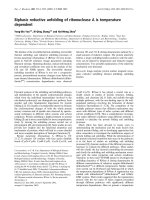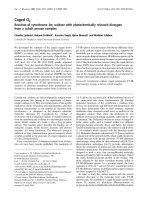Báo cáo y học: "Stewart’s Textbook of Acid-Base, 2nd edition" potx
Bạn đang xem bản rút gọn của tài liệu. Xem và tải ngay bản đầy đủ của tài liệu tại đây (215.61 KB, 2 trang )
Available online />Page 1 of 2
(page number not for citation purposes)
This multi-author textbook provides a comprehensive under-
standing of the Stewart approach to acid-base. The book
consists of 30 chapters, grouped under three sections. Section
1 is a reproduction of Peter Stewart’s original work (9
chapters), section 2 is a detailed primer on quantitative acid-
base chemistry (8 chapters), and the third section deals with
the clinical applications of the Stewart approach (13 chapters).
Retaining Stewart’s original masterly work represents one of
the highlights of the book. In the new section, the coverage is
broad, and certain chapters such as those on intracellular [H],
buffers, and the use of the Stewart model at the bedside are
exceedingly well written. The chapters on the Stewart
approach during pregnancy and a review of comparative
animal physiology are useful additions.
However, criticisms can be made. Important errors of fact
have slipped through the proofreading process, along with
some controversial assertions. To illustrate:
Table 13.1: The normal plasma ionized calcium concentration
is reported as 1 mEq/L, which is equivalent to 0.5 mmol/L.
The normal plasma ionized calcium concentration ranges
from 1.1 to 1.3 mmol/L. Similarly, the generic intracellular fluid
(ICF) calcium concentration is reported as 35 mEq/L, which
is equivalent to 17.5 mmol/L. This is exceedingly high. The
intracellular [Ca] is of the order of nanomoles per litre.
Table 21.1: The strong ion difference (SID) of gelofusine is
reported as 30, whereas the correct value is 34 (manu-
facturer’s data).
Table 28.2: The SID of 5% albumin is reported as 0. The SID
of 4% albumin is 12. The SID of 5% albumin is unlikely to be
0, which would result in a highly acidic solution.
Section 27.4: It is suggested that elevated lactate from
catecholamines results from increased Krebs cycle activity. It
is actually due to accelerated glycolysis. In this section, it is
also suggested that reliance on base excess as a
resuscitation target in patients receiving catecholamines may
lead to an inappropriate diagnosis of hypoperfusion, as base
deficits can result purely from catecholamine-induced hyper-
lactatemia. Similar errors can result from the use of strong ion
gap (SIG) (when lactate is not included in the calculation).
Finally, it is asserted that standard base excess (SBE) is un-
stable as partial pressure of carbon dioxide (PCO
2
) changes.
SBE, unlike actual base excess (ABE), is extremely stable
over wide ranges of PCO
2
.
Errors and controversial statements such as these might
pose a problem to ‘Stewart naïve’ doctors, the targeted
readership. Moreover, the book lacks an index. Whilst this
was a deliberate editorial choice, it is my belief that for a
quick search for a topic or an equation, an index would have
been useful.
An appendix at the end summarizing all of the equations also
would have been useful. For example, there are two different
versions of the corrected anion gap (AG) equation
(presumably because of usage of different units) on pages
324 and 340 and two different equations for SIG on pages
324 and 344.
These criticisms aside, the book on the whole makes
excellent reading and is a good value for the money
(€69.95). To the many who perceive the Stewart approach
as a complex mathematical minefield (particularly those in
whose minds the traditional acid-base approaches are deeply
entrenched and sacrosanct), I would recommend this book
as essential reading. In every chapter, the subject matter is
Book report
Stewart’s Textbook of Acid-Base
, 2nd edition
Bala Venkatesh
Department of Intensive Care, Princess Alexandra and Wesley Hospitals, University of Queensland, Queensland,
QLD 4102, Australia
Corresponding author: Bala Venkatesh,
Published: 19 June 2009
Critical Care 2009, 13:306 (doi:10.1186/cc7906)
This article is online at />© 2009 BioMed Central Ltd
Stewart’s Textbook of Acid-Base. 2nd edition. Edited by Kellum JA, Elbers PWG. Lulu Enterprises, UK Ltd; 2009.
ISBN-10: 1409254704; ISBN-13: 978-1409254706. 504 pages.
PCO
2
= partial pressure of carbon dioxide; SBE = standard base excess; SID = strong ion difference; SIG = strong ion gap.
Critical Care Vol 13 No 3 Venkatesh
Page 2 of 2
(page number not for citation purposes)
dealt with systematically from the basics to the final
conclusion without telescoping any steps at any stage. This
book is a valuable addition to every medical library.
Competing interests
The author declares that they have no competing interests.









